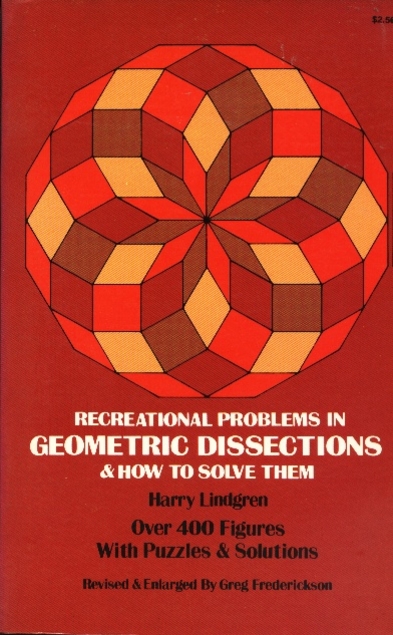
Recreational Problems in Geometric Dissections & How to Solve Them
by Harry Lindgren, and revised by Greg Frederickson, published by Dover Publications.
Softcover: 1972.

Let's jump back in time - way, way back - to 1972, when a 25-year-old math teacher at a junior high school in Baltimore, Maryland wrote the following preface for the revision of Harry Lindgren's 1964 book Geometric Dissections:
Several years ago I picked up the first edition of this book. It immediately fascinated me. Not that I really understood how the dissections were figured out---I guess I was just enticed by the diagrams. Off and on I would pull the book down off my bookshelf and spend an hour marveling at the beauty of the dissections. I especially liked the chapter on star dissections, and I wondered how anyone could ever figure out something so beautiful. I never thought I could.
But then, perhaps dissections always happen by accident. In the early morning hours of May 30, 1971, I was fiddling around with Harry Lindgren's dissection of {8/2} into {4} (Fig. 19.6). All of a sudden I realized I had reduced by one the number of pieces needed for the dissection. A wild "eureka!" exploded: I had my first dissection record! Many more have come since then. Always they have been unexpected---coming before work, late at night, during meals, or at other times when something else was planned.
And after every couple dissections I would hurry off to get them copied and then mail them halfway around the world to Harry Lindgren in Australia. It must have seemed strange to him: to have written a book eight years ago which was sliding comfortably onto the recreational math book lists: then, suddenly, a profusion of letters from America, dashed off by an excited young man who seemed afraid he might die before the latest dissection was in someone else's hands. Harry Lindgren, who had turned to other interests after the publication of his book, patiently answered all of these letters, with understanding and encouragement. For he knew the power that such a subject could exercise on one.
Since I was the one who rendered parts of the work out of date, Harry Lindgren assigned me the responsibility of revising his book. This I have done by adding an Appendix H and correcting and adding entries in Appendices E and F. This method of revision was chosen over correcting the main part of the text, so that the book could be republished quickly and inexpensively. Moreover, the out-of-date dissections remaining in the text provide an additional advantage; by comparing the new dissections with those in the text, the reader can see how the dissections were improved upon and how gaps in the text were filled in. For the ambitious reader this leaves a challenge: gaps still remain and certainly not all the dissections are minimal. Who will be the one to write the next appendix?
I would like to thank Joseph S. Madachy, editor of the Journal of Recreational Mathematics, for encouraging me to write the articles from which much of Appendix H comes. Thanks also go to Martin Gardner, who was instrumental in getting this book reprinted. Finally, a special word of thanks to Harry Lindgren, who through his book introduced me to a fascinating pastime.
Further details about this back-story
A Russian translation
Reviews.
Citations.
Polish translation of my preface
Last updated January 9, 2020.